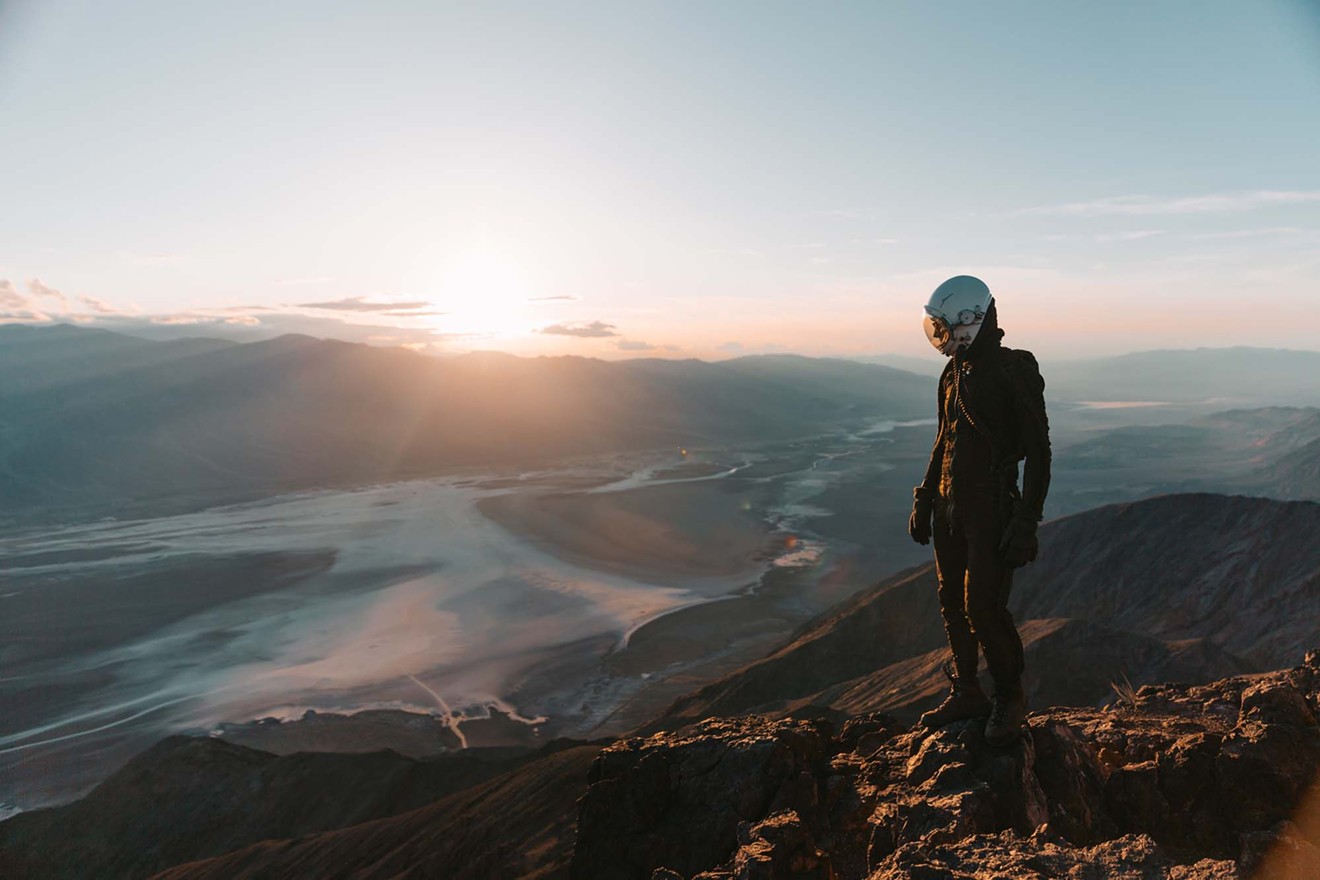Kirk, a Fort Worth-based photographer and filmmaker, started the project after the life he'd planned fell apart. Enamored of outer space since he was a child, he always dreamed of owning a spacesuit and finally bought one on eBay a few days after he and his former fiancée called it quits. It isn't quite the Mercury suit he wanted, but it's close — a Chinese military surplus high-altitude suit.
“It’s not technically a spacesuit, it’s more an edge of spacesuit, but it’s the same kind of pressure suit that the Mercury astronauts wore,” Kirk says.
Suit in tow, Kirk set out to find the most desolate, otherworldly landscapes in the country to take self-portraits while wearing the suit. Embarking on an ambitious project was a way to keep his mind busy and to figure out a new future for himself. Thirty of the photographs he took are on display at the Fort Worth Community Arts Center.
Kirk strides across pale, mushroom-shaped rock formations, looms over dark red rock canyons and clambers between giant boulders surrounded by rocks that look like outsized chunks of broken honeycomb. He paces away from the camera out of focus, leaving behind him a track of fresh, in-focus boot prints in white sand, and gazes up at the towering Shiprock, a geologic formation that juts out of the New Mexico desert like half of a capsized boat. In the exhibition's single midrange shot, the craggy red horizon reflects on Kirk's helmet visor, just below his open eyes.

Dallas filmmaker and artist Wesley Kirk went to several deserts in a spacesuit for his latest project.
Wesley Kirk
The exhibition's soundtrack features the same all-instrumental, sci-fi movie music playlist that Kirk listened to every time he set out on a shoot or sat down to edit. Tracks from Interstellar, Gravity, Solaris and Ex Machina helped get him in the right mind set and became an integral part of the project.
Kirk sought out barren landscapes devoid of vegetation, intentionally selecting rock formations and hard, dry mounds of dirt. The breakup was such a cataclysmic life shift that he feels the word "breakup" comes up short. Kirk lost his house, his fiancée, his business partner, and his dog and cat all at once.
“And so everything was different. … It doesn't feel right, calling it a breakup. And so I just felt really lost about what the future was going to be,” he says.
"You can only hear your heartbeat and your breath ... That first shot really felt like I was on another planet.” — Wesley Kirk
tweet this
But Kirk used that emptiness to push himself. Searching for barren landscapes, he also opened himself up to a new life plan. On the day he was set to elope, Kirk sat at Devil’s Bridge in Sedona, Arizona, where the couple had planned to wed, and wrote the script of the short film that plays in the gallery with the exhibition.
“Since I knew that day was going to suck no matter what, I figured I would just make it all the way suck and focus my energy into something productive,” Kirk remembers.
That day gave him the catharsis he needed, and from then on, Kirk was able to move forward. He planned to be more open and to look for how to make the people around him happy, rather than critiquing them.
“You can't control other people, but you can control yourself and do what you can for others,” he says.
Dry hills of dirt cracked and hardened by sun and wind play on screen as a woman narrates in the film: “Home, comfortable, safe, familiar. There was once a world we called home. It was happy, easy.”
Kirk asked his friend and local artist Penny Halcyon to wear the suit for the short video that goes along with the photographs, so that he could be behind the camera to get it just right. Halcyon walks methodically across sand and rocks at sunrise. As the sun comes up, she parachutes onto the desert.
Midway through the film, in a tight shot of her face, Halcyon smiles and speaks the line, “What if the world didn't simply vanish? What if the world left because of me?” It's a turning point in the film. From then on, Kirk's journey is one of hope and reflection.
The Fort Worth Community Arts Center's goal is to support local and regional artists and to display new and creative work, says the center's director, Marla Fleischmann Owen. For her, art is an essential part of the culture and a different lens through which to see the world.
“I love that artists take their personal experiences and express them in ways that are different,” she says, explaining why Kirk's work spoke to her. “You can really feel the emotion behind where he came from.”
For Kirk it all started with two cameras and 99 rolls of film. When he was 13, his mother accidentally bought two Fujifilm cameras; his father quit his job as an insurance adjuster and had 99 rolls of film left over. Kirk set about using those rolls. The camera was a simple point and shoot, and he couldn’t make it do everything he envisioned, but his parents would develop anything he shot. Around that time, he had an idea for a short film, and his parents indulged him by buying cheap Sony Handycam.
While Kirk won’t say what that first film was about, it was the start of his creative career. In exchange for help with homework, he roped his friends into acting in films, producing roughly 30 a year in high school. During his time at the University of North Texas, Kirk was frustrated by the lack of depth to the program and started a short-film club to fill in the gaps in the curriculum. Today, that club is a UNT official extracurricular.
After college, he went into business for himself and does corporate and commercial film gigs so he can afford personal projects like The World We Knew is Gone.
Every time he set out to shoot, Kirk loaded the spacesuit into a duffel bag, along with water and flashlights, and hiked a mile or two to get away from parking lots and people. With his camera gear in a backpack, he carried roughly 60 pounds of gear. Reaching a location, he set the camera shot and used a stand to figure out where he would fit in the frame. Then it was time for the suit.
The suit takes about 20 minutes to put on, mostly because it’s tricky to attach the helmet. Once he was in, Kirk wore the suit for an hour or two before taking it off. The first time, a later start than he intended put him on location at Monahans well after sunset.
To get the shot, Kirk set his camera to a slow shutter speed, which meant that he had to stand perfectly still or the shot would blur. He put the visor in the suit down, blocking out all sound and part of his field of vision.
“Once the visor comes down, all I can see is the stars and every breath is fogging up the visor. You can only hear your heartbeat and your breath ... That first shot really felt like I was on another planet,” he says.
The day after he helped his ex pack up and move, he set out for a week and a half in the Bisti Badlands desert in New Mexico. Every sunrise and sunset he loaded up and hiked out to photograph. Miles from the nearest significant town, he saw hardly anyone else.
“The world that we live in today is almost unrecognizable to what we all thought the world was going to be.” — Wesley Kirk
tweet this
“You're just out in a place that doesn't look like anything you've ever seen before. And you can't hear anything but the wind. The isolation just, it feels really nice,” Kirk says.
Although the title of the project and the harsh nature of the landscape, coupled with the palpable relief when both the film and still photos resolve with the reintroduction of vegetation to the images, the project was not designed to have a heavy environmental or cultural message, Kirk says. He's already planning a future project with a more overt message, but this one is mostly personal.
“It's not about the culture,” he says. “The world that we live in today is almost unrecognizable to what we all thought the world was going to be.”
Working way out in the desert, usually by himself, Kirk had a few close calls: the shot in which his camera was separated from him by a cleft and a 1,000-foot drop-off, which he had to jump every time he wanted to check the camera, and the time he woke up after waiting for the clouds to clear and found a scorpion next to his head.
The scariest incident came while shooting inside an old lava tube in Arizona. The mile and a half sloping tube extends deep underground into darkness so dense that it looked the same to Kirk when his eyes were open or closed, if his flashlight was off. But no other photos had a flashlight in them, so in order to maintain the integrity of the shoot, he had to extinguish the light. In place in front of the camera, with no light and the visor of the spacesuit helmet down, Kirk couldn’t see anything and was cut off from sound so thoroughly that a person could have been standing next to him and he wouldn’t have known.
In the image from this shoot that made it into the show, under the low arch of the lava tube ceiling, Kirk is sharply turned away, his helmet a sliver of light where the camera’s flash reflected off its surface. When the shutter fired, Kirk thought he heard and saw something, even though he physically could not have. Spooked, he turned to look. In the next shot, snapped a second later, he is running toward the camera. He grabbed his gear and sprinted out of the cave, where he found that the sun had set. As coyotes howled, he kept running until he reached the car.
In the second-to-last shot in the 30-photo exhibit, Kirk looks out over rows of sandy canyons. Smoke from a wildfire rises up in the distance and a few skeletal charred trees frame him. It’s the first time vegetation appears in the images and it signals a return from the otherworldly journey. In the final shot, Kirk is seated by an alpine lake, verdant green trees in the distance, the water and trees a relief after the stark, barren landscapes. He relaxes, one arm draped across a raised knee, helmet on the ground.
“Also [it's] the first time you see water, there's trees in the distance. So that way it would have more of a feeling like, like home, like landing somewhere livable,” he says.
Standing in the middle of the gallery, Kirk looked around at the expanse of photographs, signifying 18 month’s worth of work and self-discovery. It's been quite a trip.
“A lot of beautiful places,” he says, affectionately, looking around the room.
The exhibition The World We Knew is Gone runs through Oct. 23. The Fort Worth Community Arts Center, 1300 Gendy St., is open Monday through Saturday, 9 a.m. to 5 p.m.













